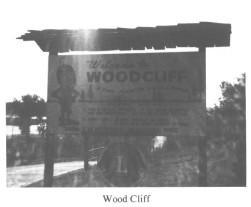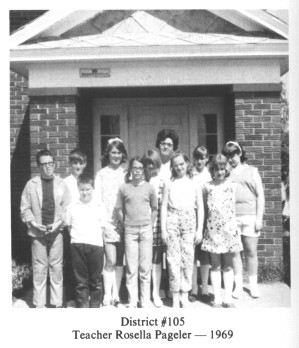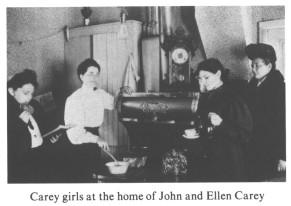 |
POHOCCO PRECINCT |
|
games, mainly ante-i-over. They made their own balls from cloth and string tightly wound to form a ball. They also played Pump-Pump-Pull Away and Run-Sheep-Run. If it was raining or snowing they played Pussy Wants the Corner or Blind Man's Bluff in the school house. Early in the Roosevelt Administration a new brick school house was built, probably about 1931 or 32. It was the first WPA school built in the county. One student, Jamie Lindgren, is a 4th-generation family attending this school -- Nettie (Maxwell) McClean, James A. McClean, Patti (McClean) Lindgren, Jamie Lindgren.
DISTRICT 82 CAREY HIGH |
 |
| Northern National Gas Line crosses Platte River |
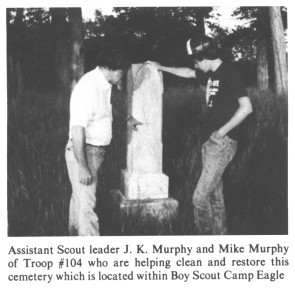 |
| Assistant Scout leader J.K. Murphy and Mike Murphy of Troop #104 who are helping clean and restore this cemetery which is located within Boy Scout Camp Eagle |
PIONEER CEMETERY
The Pioneer or Chritton Cemetery lies just south of the Platte River in Pohocco Precinct on the present-day site of the Boy Scouts Camp northeast of Cedar Bluffs. It came into existence when homesteader, Enoch Chritton, set aside two acres of his land for a family burial place in the late 1860's. It was at the edge of the timber on a sunny hillside sloping west.
He buried his wife, two daughters, and several grandchildren there, and later joined them himself in 1883. As the need arose, the ground became a community burial place and was used as such until 1898 when the new Maple Grove Cemetery was platted near Cedar Bluffs.
The cemetery became a jungle of briars, brambles and scrub oak, as years went by. It became almost impenetrable with dense undergrowth. The iron fence enclosing the Chritton burial plot became covered with brambles. Vandals, over the years, have carried away many headstones. Monuments have been overturned and some markers have been found on the banks of the Platte River far below. There have been several attempts at grave robbing.
Through the efforts of the Boy Scouts, the cemetery has been cleaned and tended until it looks much like it did many years ago. Rimmed by majestic pine and cedar trees, planted over 100 years ago, a fitting resting place is created for this hearty group of pioneers. Compiled by stories written by descendants of Enoch Chritton -- submitted by Terrilee Freeman Roberts.
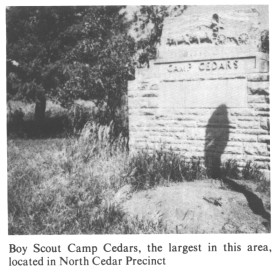 |
| Boy Scout Camp Cedars, the largest in this area, located in North Cedar Precinct |
CAMP CALVIN CREST
Calvin Crest is a year-round camp-conference retreat center located on a 250 acre site overlooking the Platte river two miles west of Highway 77. The center is designed and operated for religious and educational programming. When the facilities are not being used for religious or educational purposes, other events are scheduled. Calvin Crest is open to churches, community, civic and private groups. The camp can accommodate up to 90 persons in the winter and up to 180 persons during the summer months.
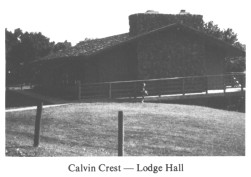 |
| Calvin Crest -- Lodge Hall |
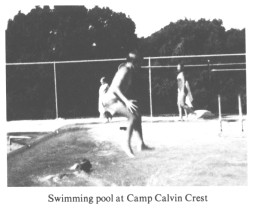 |
| Swimming Pool at Camp Calvin Crest |
Rev. Don Proett of Wahoo was a member of the special committee appointed to search for a camp site.
In October, 1958, 170 acres of the Jurgen's farm near Fremont was purchased and development began. Two Saunders County residents, Fritz Lichtenberg and Rev. Walter Millett, both of Cedar Bluffs were members of the original development committee.
In 1970, 80 acres of the Barrett property to the west was added to the camp site.
Development has continued over the years and the following facilities are now available: Eppley Lodge includes an adult housing and office facility, six winterized cabins, 2 summer A-frame cabins, twelve covered wagons, the Dining Hall (housing 2 dining halls and the kitchen), a swimming pool, tennis and basketball court; the Area Lodge -- meeting space on two levels, two residences for site staff, and an area for tent and trailer camping.
The camp serves over 200 different groups each year, involving over six thousand people.
On July 10, 1983, Camp Calvin Crest will be celebrating its 25th Anniversary with a special day of activities. Submitted by Russell Napier
RIVERCREST BIBLE CAMP
The Rivercrest Bible Camp had its beginning in the year 1958 when the Western District of the Christian & Missionary Alliance purchased a 30-acre plot of ground from John Harold and Iva M. Bouer, for the sum of $4,500.
It was established and is maintained as a site for Christian activities such as Youth Bible Camps, Family Bible Conferences, Retreats, etc. Alliance groups are given preference in the use of the facilities but many Non-Alliance groups also use the camp for Christian enrichment.
It is a relatively small camp, but can accommodate up to 125 or more in the summer and 30-40 in the winterized area.
The early camping experiences were on the primitive side for a few years, with tents being used until the different buildings were added year after year. There are now 15 buildings, which include in part the beautiful Ken Steel Memorial Chapel and
page 107
| Back | Contents | Next |
The Saunders County NEGenWeb Project

